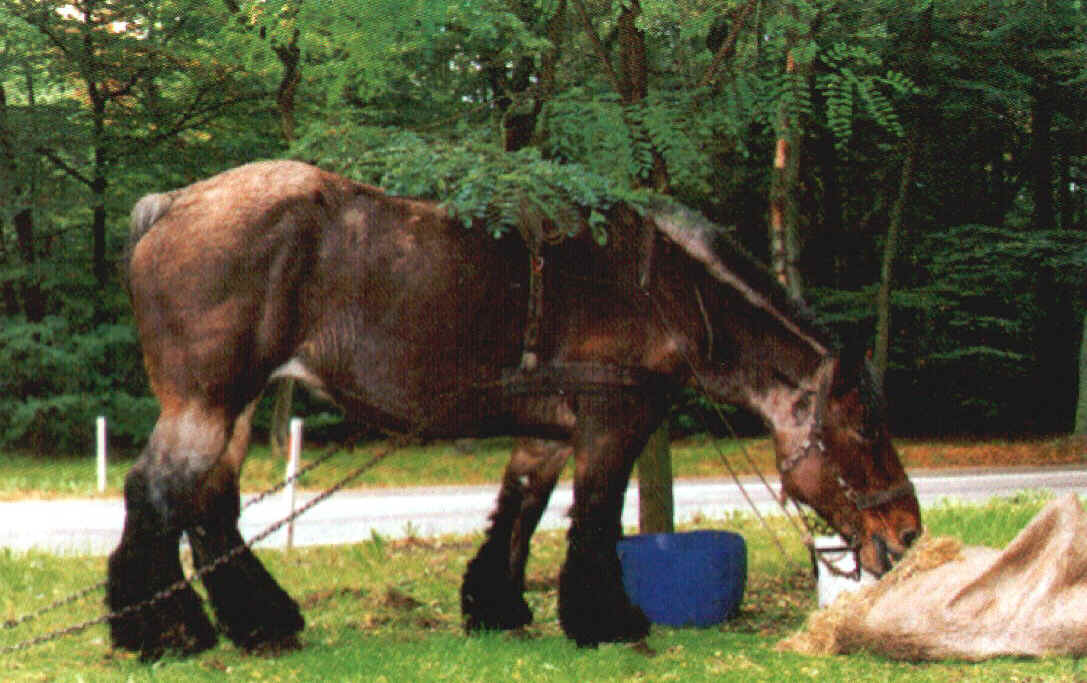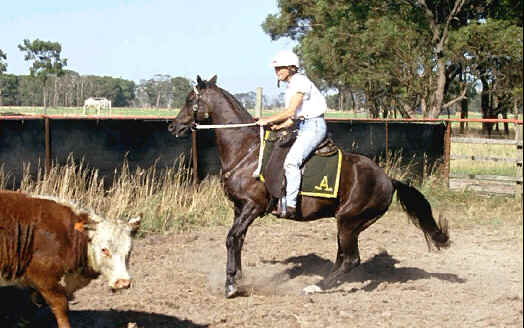



AUSTRALIAN STOCKHORSE
 Breed
of horse developed in Australia after World War I (1914-1918) for
working with cattle and hauling freight. The Australian stock
horse has a strong, well-proportioned body with slender legs. It
stands about 158 to 163 cm (about 62 to 64 in, or 15.5 to 16
hands) high at the withers(the high part of the back, located
between the shoulder blades). Broad hindquarters increase the
flexibility of this horse, and the back is well-suited for
carrying a saddle. Intelligent eyes give it an alert expression.
The Australian stock horse usually has a bay (reddish) coat, but
any color except gray is acceptable for registration as a
purebred. The first horses introduced on the Australian continent
were imported from South Africa by English settlers in 1788. They
developed a horse known as the waler, a hardy animal that was
able to carry a rider with gear over rough terrain at a good
pace, usually in hot, dry conditions. During World War I
(1914-1918), Australia supplied the Allied forces with 120,000
troops mounted on walers then regarded as the finest cavalry
horse in the world for its stamina and strength.After the war,
the few walers that remained in Australia were crossed with the
Percheron horse, quarter horse, and ponies, and eventually
produced the Australian stock horse. Although not exceptionally
fast, this horse is a good all-around worker with great stamina,
which makes it well-suited for the harsh conditions in the
Australian outback. Some sportsmen ride this horse in polo
matches.
Breed
of horse developed in Australia after World War I (1914-1918) for
working with cattle and hauling freight. The Australian stock
horse has a strong, well-proportioned body with slender legs. It
stands about 158 to 163 cm (about 62 to 64 in, or 15.5 to 16
hands) high at the withers(the high part of the back, located
between the shoulder blades). Broad hindquarters increase the
flexibility of this horse, and the back is well-suited for
carrying a saddle. Intelligent eyes give it an alert expression.
The Australian stock horse usually has a bay (reddish) coat, but
any color except gray is acceptable for registration as a
purebred. The first horses introduced on the Australian continent
were imported from South Africa by English settlers in 1788. They
developed a horse known as the waler, a hardy animal that was
able to carry a rider with gear over rough terrain at a good
pace, usually in hot, dry conditions. During World War I
(1914-1918), Australia supplied the Allied forces with 120,000
troops mounted on walers then regarded as the finest cavalry
horse in the world for its stamina and strength.After the war,
the few walers that remained in Australia were crossed with the
Percheron horse, quarter horse, and ponies, and eventually
produced the Australian stock horse. Although not exceptionally
fast, this horse is a good all-around worker with great stamina,
which makes it well-suited for the harsh conditions in the
Australian outback. Some sportsmen ride this horse in polo
matches.
Akhal Teké - Andalusian - Appaloosa - Arabian - Ass - Australian Stock Horse - Bashkir Belgium Heavy Draft horse - Cleveland Bay - Clydesdale - Dutch Warmblood - Gelderlander - Hackney - Holsteiner - Paard (algemeen) - Irish Draught - Lippizaner - Missouri Fox Trotter - Morgan Horse - Mule - Mustang - Oldenburger - Palomino - Percheron - Peruvian Paso - Pinto - Quarter Horse - Selle Francais - Standardbred - Tarpan - Tennessee Walker - Trakehner - Ungulate (onevenhoevigen) - Zebra -